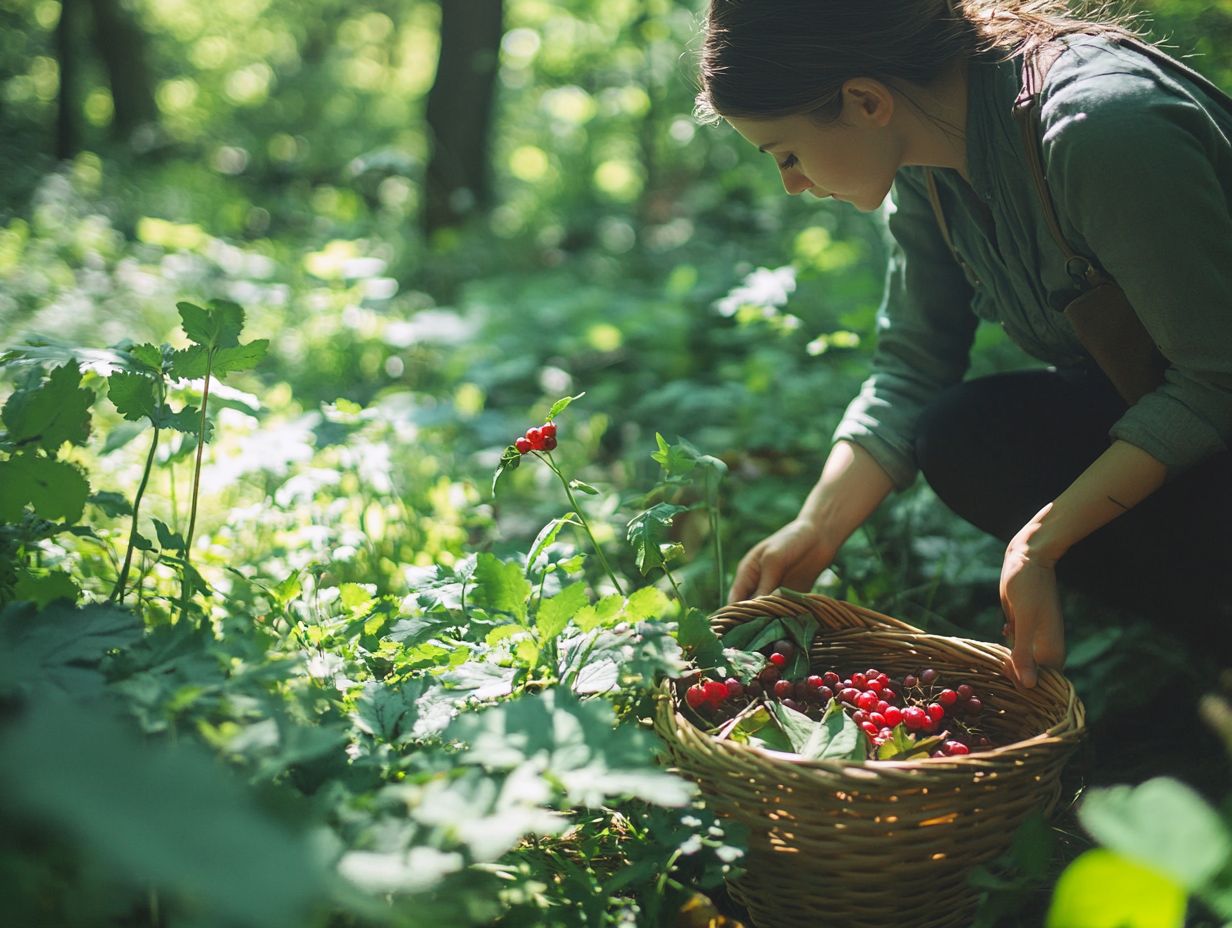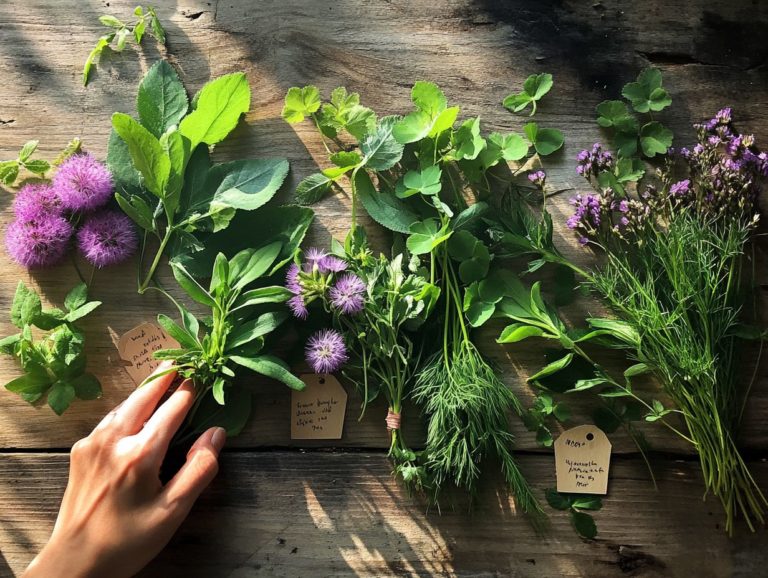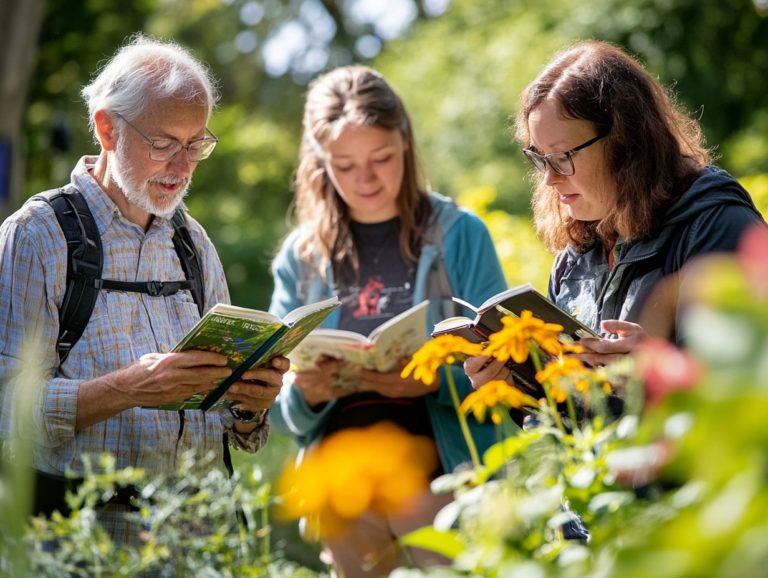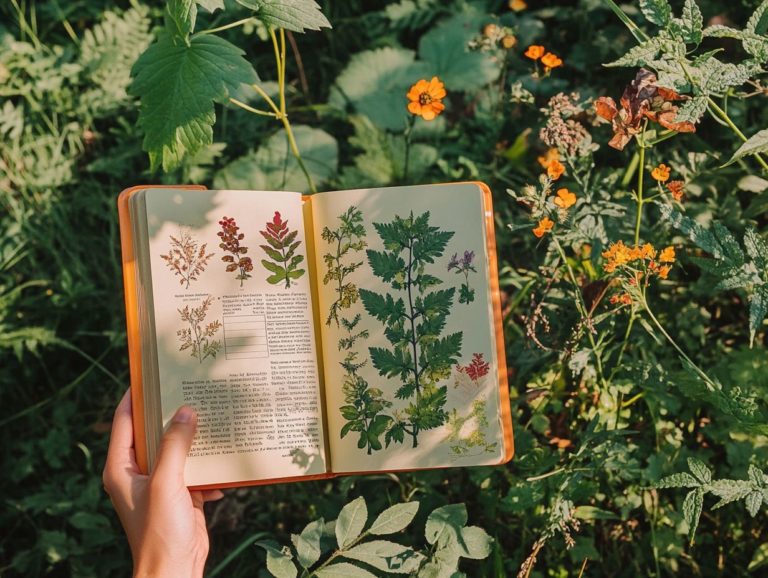The Basics of Foraging: Identifying Edibles
Foraging is more than just a trend. It offers a fulfilling way to connect with nature and discover edible plants around you.
This exploration dives into foraging’s health benefits and its positive impact on the environment. It highlights key traits for identifying safe, edible plants.
You ll discover common finds and essential safety precautions. Understanding ethical foraging practices is crucial for all foragers.
Contents
Key Takeaways:

- Foraging is searching for food in the wild, offering numerous health and environmental benefits.
- When identifying edible plants, look for color, texture, and smell to ensure safety.
- Common edible plants include dandelions, wild berries, and mushrooms, which can be used in salads and teas.
What is Foraging?
Foraging is the art of gathering wild edibles like mushrooms, plants, and fruits. This ancient skill connects you to the rhythms of nature.
Mastering foraging can elevate your culinary repertoire. Discover nutritious snacks and ingredients often overlooked today.
Whether you re a novice forager or a seasoned wildcrafter, foraging is a treasure trove of discovery.
This practice enhances your appreciation for biodiversity and supports sustainability by sourcing food from your environment.
With seasonal shifts come wild edibles like berries, dandelion greens, and ramps, each offering unique flavors.
Engaging in foraging connects you with the ecosystem and inspires advocacy for conservation.
Ultimately, it transforms your relationship with food into a journey of taste and mindfulness.
Benefits of Foraging
Foraging offers benefits that extend beyond gathering food. It nurtures your health and enhances your environmental awareness.
Incorporating wild edibles into your diet allows you to savor nutritious and delicious snacks. This practice aligns perfectly with a sustainable lifestyle.
Joining foraging groups enriches your experience. You ll gain insights into local plants, safety tips, and potential allergic reactions.
Health and Environmental Benefits
The health benefits of foraging are compelling, especially when it comes to indulging in wild edibles. These natural treasures often boast a richer nutrient profile compared to their cultivated counterparts, offering essential vitamins and minerals that contribute to a balanced diet.
Foraging invites you to embrace sustainable practices, allowing you to gather nature’s bounty without exacerbating environmental issues. By familiarizing yourself with the local ecosystem and learning to identify edible varieties, you actively participate in maintaining biodiversity while enjoying nutritious snacks that enhance your overall well-being.
These wild plants and fungi are often brimming with antioxidants and provide dietary fiber and unique natural compounds found in plants that may bolster your immune function. Incorporating a diverse array of wild edibles into your diet can reduce the risk of chronic diseases and support gut health, thanks to their prebiotic properties.
Foraging has a minimal carbon footprint, eliminating the need for transportation and curbing reliance on commercial agriculture. Engaging in foraging deepens your connection with nature, fostering awareness of local flora and its vital role in preserving ecosystems. Foraging is not just about health; it s an adventure waiting for you!
Identifying Edible Plants

Identifying edible plants is an essential skill for anyone venturing into the world of foraging. Understanding the basics of foraging is key to successful foraging.
Recognizing key characteristics and distinguishing features that set safe, nutritious plants apart from their poisonous counterparts is crucial. By utilizing plant identification resources such as guides and apps, you can significantly enhance your ability to confidently identify wild edibles. For those just starting out, what beginners should know about foraging can help turn it into a safe, rewarding adventure.
Key Characteristics to Look For
When you venture into foraging for wild edibles, recognizing the key characteristics that separate edible plants from their poisonous counterparts is essential. For a comprehensive overview, refer to Wild Edibles: A Safe Forager’s Guide to Identification. Pay attention to traits like leaf shape, growth patterns, flower types, and distinct markings. These details will guide you in identifying common plants safely.
Take mushrooms, for example; it s crucial to differentiate between delectable varieties like morels and toxic ones such as the Death Cap. Beyond just the color and texture of leaves, consider the environment where the plants flourish. Dandelions often sprout in urban landscapes, while deadly plants like hemlock prefer moister, shadier spots.
The time of year also matters; some plants only provide edible parts during specific seasons. Observing how leaves are arranged along a stem can reveal distinctions between species. For instance, the poisonous foxglove typically displays spiral arrangements, while the safe-to-eat lamb’s quarters showcases an alternate pattern.
Grasping these nuances not only boosts your foraging success but also underscores the importance of caution and continuous learning in the art of wild food gathering.
Common Edible Plants to Forage
Common edible plants to forage encompass a delightful array of wild edibles for beginners available in various settings, from urban gardens to sprawling rural landscapes.
Start your seasonal foraging adventure now and gather a diverse range of ingredients, such as dandelion greens, blackberries, and pine nuts, offering not just culinary versatility but also a profound connection to nature.
By mastering the optimal harvesting times for each plant and discovering how to incorporate them into your recipes, you can elevate your foraging experience, transforming it into an adventure that culminates in a delicious exploration of the edible world around you.
Examples and Uses
You might consider foraging wild edibles like dandelion greens, which elevate salads. Rose hips are celebrated for their impressive vitamin C content, while blackberries are perfect for making jams and desserts.
Dandelion greens bring a delightful peppery kick to any dish. They are ideal for saut ing or blending into a vibrant pesto.
Seasonal foraging fosters a deeper appreciation for local plants and animals. Each ingredient reflects the time of year.
Foraging Safety

Safety should be your top priority when foraging. Mistakenly identifying poisonous plants or suffering from allergic reactions can lead to significant consequences.
To ensure a safe and enjoyable foraging experience, it’s crucial to follow established safety guidelines. Thoroughly research local flora and utilize trustworthy plant identification resources, including the ultimate checklist for foraging edibles.
Stay well-informed about common poisonous plants like hemlock and oleander. If you re new to foraging, venture out with an experienced guide or join a group. This enhances your safety and enriches your knowledge through shared experiences.
Precautions and Guidelines
When you venture into foraging, it s essential to follow specific precautions. Familiarize yourself with poisonous plants in your area, like poison ivy and the Death Cap mushroom.
Always cross-reference information before consuming wild food. If you have food allergies, be cautious, as certain edible plants can trigger unexpected reactions.
Start your foraging journey with someone experienced. Their insights can help you identify safe plants and point you towards resources like wild edibles in your backyard while alerting you to dangerous look-alikes.
Always carry a field guide and use reliable apps to cross-reference the plants you encounter. Misidentifying hemlock, which resembles some edible herbs, could have severe consequences.
When trying new foraged items, test them in small amounts to monitor for adverse reactions. Forage away from polluted areas, like roadsides or industrial zones, to avoid contaminants.
Engaging with local foraging communities provides valuable insights and enriches your overall experience.
Foraging Ethics
Foraging ethics are crucial for maintaining the sustainability of wild edibles. Embrace responsible foraging practices by recognizing the significance of sustainable harvesting.
This includes knowing how much to gather while ensuring enough is left for wildlife and future growth. Connecting with local guides and joining community foraging groups enriches your understanding of ethical practices.
By adopting these principles, you can fully enjoy your foraging adventures while making a positive contribution to the environment.
Responsible Foraging Practices
Responsible foraging practices are vital for balancing nature s bounty with environmental protection. Use ways to gather food without harming nature by taking only what you need and leaving enough for local animals and future growth.
Engaging in community crowdsourcing can elevate your foraging experience. Share your knowledge and experiences with fellow foragers to enrich everyone’s practices.
Embrace a mindful approach to enjoy wild edibles while ensuring these resources last for future generations. Stay informed about local regulations and guidelines related to foraging, as they protect vulnerable species and habitats.
Rotating your harvesting locations can prevent the overexploitation of certain areas, allowing ecosystems to recover effectively. Encouraging participation in local foraging groups fosters a sense of shared responsibility among community members.
By prioritizing these principles, you enhance your well-being and help create a thriving ecosystem! Get involved and make a difference today!
Frequently Asked Questions

What is foraging?
Foraging is the act of searching for and gathering wild food sources such as plants, fruits, nuts, and mushrooms.
Why is it important to know how to identify edibles when foraging?
Identifying edibles is crucial for safety as there are many poisonous plants that can easily be mistaken for edible ones. A beginner’s guide to wild edible plants can help ensure that you can properly utilize the resources around you.
How do I start foraging and identifying edibles?
The best way to start is by researching plants, fruits, and mushrooms in your local area. Joining guided foraging walks or local foraging groups is also helpful.
What are some common edible plants and fruits?
Common edible plants and fruits include dandelions, blackberries, blueberries, and wild strawberries. Proper identification is essential before consuming them, so be sure to follow the dos and don’ts of foraging.
How can I tell if a mushroom is safe to eat?
To determine if a mushroom is safe to eat, check for specific physical characteristics, examine the gills and stem, and use a field guide or app for proper identification.
Are there any safety precautions I should take when foraging for edibles?
Yes, always wear protective clothing and gloves, avoid areas that may have been contaminated with pesticides or other chemicals, and never consume anything unless you are 100% certain of its identification.






